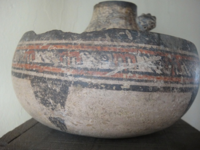Ancient footprints of Acahualinca

The Ancient footprints of Acahualinca (Spanish pronunciation: [akawaˈliŋka]; Spanish: Huellas de Acahualinca) exist in Managua, Nicaragua near the southern shore of Lake Managua. The region was once called "El Cauce".[1] The tracks are fossil Late Holocene human footprints left behind in volcanic ash and mud, which solidified about 2,120±120 years ago, shortly after the group of up to 15 people passed by.[2]
It is sometimes reported that the people were running to escape from a volcanic explosion, but the distance between the footprints indicates a walking gait.[3] Fossilized footprints of several animals are also present, but the fact that they intersect the human footprints shows they were not traveling with the people.[4]
Scientific analysis of the footprints
In 1874, construction workers discovered the footprints. The United States medical doctor and
The
Work was continued by Joaquín Matilló, Allan L. Bryan and Jorge Espinosa in the 1960s and 1970s. Allan L. Bryan, from the
Specimens of these footprints can be viewed at both the
Acahualinca Museum
The "Museo Sitio Huellas de Acahualinca" is located at west of Managua, in the eponymous Acahualinca town. The museum was founded in 1953 by Nicaraguan scientist Leonor Martínez, later in 1989, was rescued, restored and fitted out with the support of "ASDI" and the Historical Museum of Sweden. In addition to footprints, the museum features a small collection of pottery and other items of archaeological interest from several sites in Nicaragua. Previously there were
Gallery
See also
- Eve's footprint — footprints of a single female found at Langebaan, South Africa in 1995, dating to approximately 117,000 years ago.
- Happisburgh footprints — early Pleistocene fossilized hominid footprints found in a sediment layer on a beach at Happisburgh in Norfolk, England, dating to more than 800,000 years ago,
- Ileret — footprints of Homo erectus found at Ileret, Northern Kenya, dating to approximately 1.5 million years ago.
- Laetoli footprints — a line of hominid footprints, discovered at Laetoli, Tanzania by Mary Leakey in 1976, dating to approximately 3.6 million years ago.
- List of fossil sites (with link directory)
- List of hominina (hominid) fossils(with images)
References
- JSTOR 983095.
- ^ S2CID 43686540.
- ^ a b Bryan, Alan L (1973). "New light on ancient Nicaraguan footprints". Archaeology. 26 (2): 146–147.
- ^ a b c "Acahualinca Footprints Museum, Tourist Attractions, Culture". Nicaragua.com. Retrieved 2007-10-28.
- ^ Flint, Earl (1884). "Human footprints in Nicaragua". Am. Antiquarian. 6: 112–114.
Flint, Earl (1885). "Human footprints in Nicaragua". Am. Antiquarian. 7: 156–158. - ^ Carnegie Institution of Washington. "Geologic observations on the ancient human footprints near Managua, Nicaragua". Contributions to American Anthropology and History. 11 (52).
- ^ "Ancient footprints of Acahualinca". ViaNica. Retrieved 2007-10-28.
- JSTOR 1299291.
External links
- Human Timeline (Interactive) – Smithsonian, National Museum of Natural History (August 2016).


